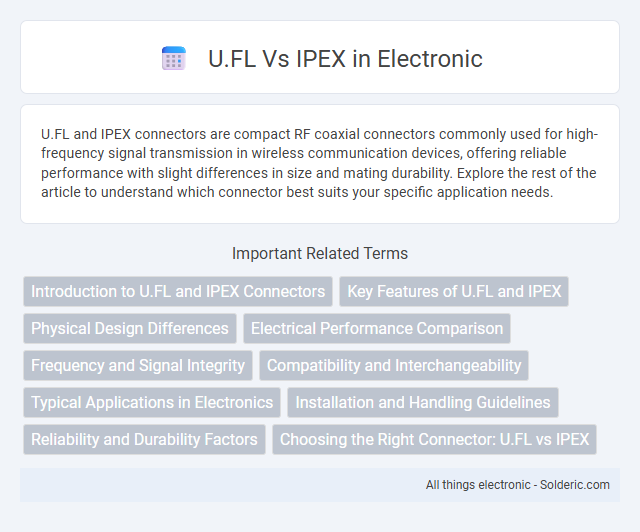U.FL and IPEX connectors are compact RF coaxial connectors commonly used for high-frequency signal transmission in wireless communication devices, offering reliable performance with slight differences in size and mating durability. Explore the rest of the article to understand which connector best suits your specific application needs.
Comparison Table
| Feature | U.FL (IPX) Connector | IPEX Connector |
|---|---|---|
| Connector Type | Micro coaxial RF connector | Micro coaxial RF connector |
| Size | 2.5mm diameter | 2.0mm diameter |
| Impedance | 50 Ohms | 50 Ohms |
| Frequency Range | Up to 6 GHz | Up to 6 GHz |
| Durability (Mating Cycles) | About 30 cycles | About 30 cycles |
| Application | Wi-Fi, cellular modules, GPS antennas | Wi-Fi, cellular modules, GPS antennas |
| Compatibility | Widely used, standardized by Hirose Electric | OEM variants, similar but less standardized |
| Cost | Generally low-cost | Low to moderate cost depending on vendor |
Introduction to U.FL and IPEX Connectors
U.FL and IPEX connectors are highly compact RF connectors widely used in wireless communication devices such as Wi-Fi modules, GPS units, and IoT sensors, offering reliable high-frequency signal transmission. U.FL connectors, developed by Hirose Electric Group, are known for their small size and ease of installation, typically used in PCB applications with cables up to 1.37mm diameter. IPEX connectors, often used interchangeably with U.FL, are compatible variations produced by I-PEX, providing similar performance and form factor, ensuring your wireless devices maintain optimal RF connectivity and signal integrity.
Key Features of U.FL and IPEX
U.FL connectors are compact, highly reliable RF connectors designed for high-frequency signals up to 6 GHz, featuring a snap-on coupling mechanism that ensures secure connections in tight spaces. IPEX connectors, also known as MHF connectors, are similarly small and support frequencies up to 6 GHz with a push-on coupling design that facilitates easy assembly and maintenance in wireless communication devices. Both U.FL and IPEX connectors are widely used in RF and Wi-Fi modules, offering low insertion loss and excellent performance in applications requiring minimal space and high signal integrity.
Physical Design Differences
The U.FL connector features a compact, low-profile design ideal for limited space applications, measuring approximately 2.0 mm in height. The IPEX connector, also known as MHF or AMC, offers a slightly smaller form factor with a height around 1.2 mm, providing better space efficiency in ultra-compact devices. Your choice between U.FL and IPEX depends on the mechanical constraints and the required durability of the connection in your wireless or RF system.
Electrical Performance Comparison
U.FL connectors typically offer low insertion loss ranging from 0.1 to 0.3 dB up to 6 GHz, making them suitable for high-frequency applications. IPEX connectors, also known as MHF, provide a similar electrical performance with insertion loss values generally around 0.2 dB at 6 GHz, supporting frequencies up to 6 GHz or higher in some variants. Both connector types maintain characteristic impedance of 50 ohms, ensuring minimal signal reflection and consistent RF performance in applications such as WiFi, GPS, and cellular communications.
Frequency and Signal Integrity
U.FL connectors support frequencies up to 6 GHz, ensuring reliable signal integrity for high-frequency applications, whereas IPEX connectors can operate efficiently beyond 6 GHz, often reaching 8 GHz or higher for ultra-high-frequency uses. The precision design of IPEX connectors minimizes signal loss and reflection, enhancing performance in sensitive RF circuits compared to U.FL. Both connectors maintain low insertion loss and consistent impedance but IPEX is preferred in scenarios demanding superior signal fidelity at elevated frequencies.
Compatibility and Interchangeability
U.FL and IPEX connectors, both prevalent in RF applications, often serve similar functions but are not directly compatible due to differences in physical dimensions and locking mechanisms. U.FL connectors, typically smaller with a push-on mating interface, are commonly used in compact devices, while IPEX connectors feature a more robust click-on mechanism, influencing interchangeability. Adapting cables or devices with these connectors usually requires specific adapters to maintain signal integrity and mechanical reliability.
Typical Applications in Electronics
U.FL connectors are predominantly used in compact wireless devices like laptops, smartphones, and GPS modules due to their ultra-miniature size and reliable RF performance up to 6 GHz. IPEX connectors, often interchangeable with U.FL, find extensive applications in IoT devices, embedded systems, and antenna connections where space constraints and consistent impedance matching are critical. Both connector types support high-frequency signals in Wi-Fi, Bluetooth, and cellular communications, making them ideal for modern electronics requiring efficient RF connectivity.
Installation and Handling Guidelines
U.FL connectors require precise handling due to their small size and delicate snap-on mechanism, demanding careful alignment during installation to avoid damage to the mating surfaces. IPEX connectors offer a more robust design with a push-on interface, simplifying the connection process and reducing the risk of wear from repeated assembly. For your projects, following manufacturer guidelines on torque specifications and cable bending radius will ensure reliable performance and longevity of both connector types.
Reliability and Durability Factors
U.FL connectors offer higher reliability in compact applications due to their robust locking mechanism and resistance to vibration, making them suitable for densely packed electronics. IPEX connectors, while smaller and more flexible, may experience reduced durability under frequent mating cycles and mechanical stress. Material quality and design precision in U.FL contribute to longer lifespan and consistent signal integrity compared to IPEX alternatives.
Choosing the Right Connector: U.FL vs IPEX
Choosing the right connector between U.FL and IPEX depends on your device's size constraints, frequency range, and application requirements. U.FL connectors are compact, supporting frequencies up to 6 GHz, ideal for high-frequency signals in tight spaces like Wi-Fi modules. IPEX connectors offer slightly larger dimensions with robust mechanical stability, suitable for applications requiring easier handling and moderate frequency performance.
U.FL vs IPEX Infographic

 solderic.com
solderic.com